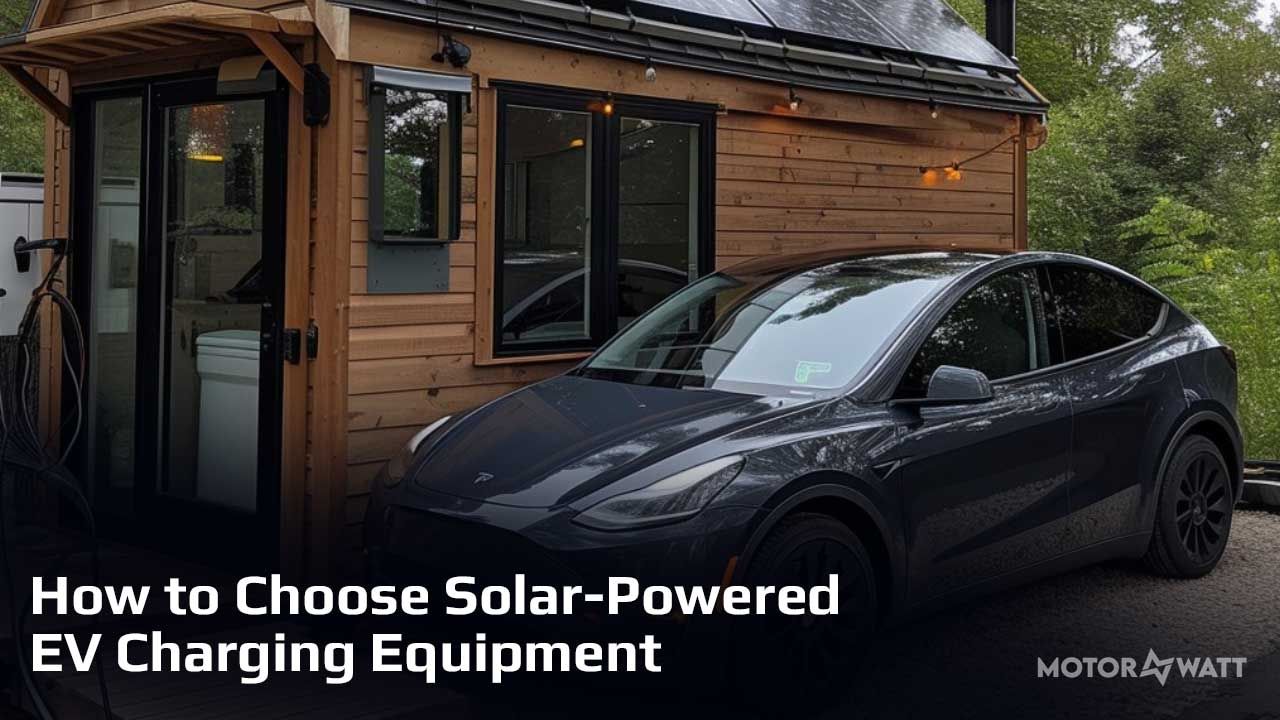How to Choose Solar‑Powered EV Charging Equipment
Share this article in Social Media:

Solar Powered EV Charging Equipment: 2025 Guide
Save 70% on charging costs with the right solar EV charging system
Key Findings
Market Growth: Solar EV charging market expected to reach $40.4B by 2034 with 37.39% CAGR
Cost Savings: Reduce charging costs by 70% compared to grid electricity
Installation Cost: Home systems range from $799 to $19,999 depending on capacity
ROI Timeline: Average payback period of 6-8 years with federal incentives
Solar-powered EV charging equipment represents the future of sustainable transportation. With electricity costs rising and environmental concerns growing, homeowners and businesses are increasingly turning to solar solutions for their electric vehicle charging needs.
According to recent market research, the global solar-powered EV charging station market is experiencing unprecedented growth, driven by increasing EV adoption, government incentives, and technological advancements. This comprehensive guide provides everything you need to make an informed decision about solar EV charging equipment in 2025.
Solar EV Charging Market Overview
The solar EV charging market is experiencing explosive growth, with a compound annual growth rate of 37.39% from 2025 to 2034.
$2.32B
Market Size 2025
$40.4B
Projected 2034
37.39%
CAGR Growth
1.3M+
New Stations 2024
Solar EV Charging Market Growth Projection
Key Market Drivers
Environmental Concerns
Rising awareness of climate change and carbon footprint reduction drives demand for clean energy solutions.
Government Incentives
Federal tax credits and local rebates make solar EV charging more affordable for consumers.
Technology Advancement
Improved solar panel efficiency and battery storage make systems more viable and cost-effective.
Cost Analysis & Savings
Understanding the financial implications of solar EV charging equipment is crucial for making an informed decision.
Installation Cost Breakdown
Home Installation
Commercial Installation
Cost Savings Analysis
Return on Investment Timeline
With federal tax credits and local incentives
Total operational period with proper maintenance
Total savings over system lifetime
Types of Solar EV Charging Equipment
Understanding different charging levels and their applications helps you choose the right equipment for your needs.
| Charging Level | Power Output | Charging Speed | Best For | Price Range |
|---|---|---|---|---|
|
Level 1
120V AC
|
1.2-1.4 kW | 4-5 miles/hour | Small solar systems, overnight charging | $799-$1,999 |
|
Level 2
240V AC
|
7.2-19.2 kW | 25-70 miles/hour | Medium-large solar systems, daily charging | $1,500-$19,999 |
|
DC Fast Charging
480V DC
|
50-350 kW | 200+ miles/hour | Commercial installations, public charging | $30K-$200K |
Solar System Size Requirements
Small System
Perfect for Level 1 charging and limited daily driving
Medium System
Ideal for Level 2 charging and moderate daily driving
Large System
Suitable for high-power Level 2 or commercial installations
Installation Types
Standalone Stations
Independent solar-powered charging stations that operate off-grid, perfect for remote locations.
Integrated Stations
Connected to existing electrical infrastructure with solar as supplementary power source.
Mobile Charging Units
Portable solar charging solutions for temporary installations or emergency charging.
Step-by-Step Installation Guide
Follow this comprehensive guide to install your solar EV charging system safely and efficiently.
Pre-Installation Assessment
Site Evaluation
- Assess roof condition and orientation
- Check for shading from trees or buildings
- Measure available installation space
- Evaluate electrical panel capacity
Energy Requirements
- Calculate daily driving distance
- Determine EV battery capacity
- Assess current energy usage
- Plan for future expansion
Design and Planning
System Design
- • Calculate solar panel requirements
- • Select appropriate inverter size
- • Choose battery storage capacity
- • Plan electrical wiring layout
Permits and Approvals
- • Obtain building permits
- • Submit utility interconnection application
- • Schedule electrical inspections
- • Verify local code compliance
Solar Panel Installation
Mounting System
- • Install roof mounting brackets
- • Secure rails to mounting points
- • Ensure proper drainage
- • Check structural integrity
Panel Installation
- • Position panels on mounting rails
- • Secure with end caps and clamps
- • Connect DC wiring between panels
- • Install grounding equipment
Electrical Installation
DC Components
- • Install DC combiner box
- • Connect solar panel strings
- • Install DC disconnect switch
- • Run DC wiring to inverter
AC Components
- • Install inverter system
- • Connect AC disconnect switch
- • Install production meter
- • Connect to electrical panel
EV Charger Installation
Mounting and Wiring
- • Choose optimal charger location
- • Mount charger securely to wall
- • Install dedicated circuit breaker
- • Run appropriate gauge wiring
Smart Features Setup
- • Configure WiFi connectivity
- • Set up mobile app control
- • Program charging schedules
- • Enable load management
System Testing and Commissioning
Testing Procedures
- • Verify all electrical connections
- • Test system grounding
- • Check inverter functionality
- • Validate charging performance
Final Steps
- • Schedule final inspection
- • Obtain utility interconnection
- • Activate monitoring system
- • Document system configuration
Typical Installation Timeline
Design, permits, and utility applications
Panel mounting and electrical work
Charger installation and setup
Final inspection and grid connection
Top Solar EV Charging Brands 2025
Leading manufacturers providing reliable and innovative solar EV charging solutions.
Tesla
Universal Wall Connector
ChargePoint
Home Flex
Wallbox
Pulsar Plus
Emporia
Pro EV Charger
Autel
MaxiCharger
Enphase
IQ Solar Charger
Feature Comparison Matrix
| Brand | WiFi | App Control | Solar Integration | Load Management | Voice Control | OCPP Support |
|---|---|---|---|---|---|---|
| Tesla | ||||||
| ChargePoint | ||||||
| Wallbox | ||||||
| Emporia | ||||||
| Autel | ||||||
| Enphase |
How to Choose the Right Equipment
Follow our step-by-step selection guide to find the perfect solar EV charging solution for your needs.
Decision Tree
Step 1: What's your daily driving distance?
Level 1 charging may suffice
Level 2 charging recommended
High-power Level 2 required
Step 2: What's your solar system size?
Small system - Level 1 charging
Medium system - Level 2 up to 40A
Large system - Level 2 up to 80A
Step 3: What's your budget?
Basic Level 1 or entry Level 2
Smart Level 2 with features
Premium system with storage
Key Factors to Consider
Power Requirements
Match charger amperage to your solar system capacity and daily energy needs.
Installation Location
Consider garage, driveway, or carport placement for optimal accessibility.
Vehicle Compatibility
Ensure connector type matches your EV (J1772, Tesla, CCS, etc.).
Smart Features
WiFi connectivity, app control, and scheduling for solar optimization.
Safety Features
Ground fault protection, overcurrent protection, and certification standards.
Common Mistakes to Avoid
Undersizing the System
Don't choose a charger more powerful than your solar system can support.
Ignoring Electrical Panel Capacity
Ensure your electrical panel can handle the additional load safely.
Skipping Professional Installation
High-voltage electrical work requires certified installers for safety and warranty.
Not Considering Future Needs
Plan for additional EVs or increased charging requirements.
Overlooking Incentives
Research available rebates and tax credits before purchasing.
Expert Recommendations by Use Case
Small Home System
Medium Home System
Large Home System
Frequently Asked Questions
Get answers to the most common questions about solar EV charging equipment.
How much can I save with solar EV charging compared to grid electricity?
According to industry analysis, solar EV charging can reduce your charging costs by 70-90% compared to grid electricity. With solar power costing $0.025-$0.03 per kWh and grid electricity averaging $0.06-$0.08 per kWh for commercial use, the savings add up quickly. For a typical EV driver covering 12,000 miles annually, this translates to savings of $800-$1,200 per year.
What size solar system do I need for EV charging?
The required solar system size depends on your daily driving distance and charging speed preferences. Research indicates that a 4-7 kW system supports Level 1 charging for up to 30 miles of daily driving, while 8-15 kW systems handle Level 2 charging for 30-100 miles daily. For heavy drivers (100+ miles daily), systems of 16+ kW are recommended for optimal performance.
How long does it take to install a solar EV charging system?
According to installation professionals, the typical timeline is 3-5 weeks total. This includes 1-2 weeks for planning and permits, 2-3 days for solar panel installation, 1 day for EV charger installation, and 1-2 weeks for final inspection and utility interconnection. Weather conditions and permit processing times can affect the schedule.
What incentives are available for solar EV charging in 2025?
The federal Investment Tax Credit (ITC) offers a 30% tax credit for solar installations through 2032. For EV chargers, there's a 30% federal tax credit up to $1,000 for residential installations. Many states offer additional rebates - California provides up to $2,000 for EV charger installations, while states like New York and Massachusetts offer similar programs. Always check local utility rebates as well.
Can I charge my EV at night with solar power?
Yes, with battery storage systems. Solar batteries store excess energy generated during the day for use at night or during cloudy periods. Industry experts recommend battery systems with 10-20 kWh capacity for residential EV charging. Without batteries, you can still benefit from net metering programs that credit your solar production during the day against nighttime grid usage.
What's the difference between Level 1 and Level 2 charging for solar systems?
Level 1 charging uses 120V outlets and draws 1.2-1.4 kW, adding 4-5 miles of range per hour. It's ideal for smaller solar systems (4-7 kW) and overnight charging. Level 2 charging uses 240V and draws 7.2-19.2 kW, adding 25-70 miles of range per hour. It requires larger solar systems (8+ kW) but offers much faster charging for daily use.
How do I know if my electrical panel can handle solar EV charging?
Most homes have 100-200 amp electrical panels. Level 1 charging typically requires a 20-amp circuit, while Level 2 charging needs 40-100 amp circuits depending on the charger. A qualified electrician should assess your panel capacity, existing loads, and available circuits. Panel upgrades cost $1,500-$3,000 if needed, but newer homes often have sufficient capacity.
Are there any maintenance requirements for solar EV charging systems?
Solar EV charging systems require minimal maintenance. Solar panels need occasional cleaning and annual inspections, while EV chargers require periodic firmware updates and visual inspections. Most manufacturers recommend professional system checkups every 2-3 years. Total maintenance costs typically run $100-$300 annually, far less than traditional vehicle fuel costs.
Ready to Make the Switch to Solar EV Charging?
Solar EV charging represents the future of sustainable transportation. With market growth of 37.39% annually, proven cost savings of 70%+, and improving technology, there's never been a better time to invest in solar EV charging equipment.
1. Calculate your energy needs
2. Get quotes from certified installers
3. Apply for available incentives
Most installations complete
within 3-5 weeks from
initial consultation
Average payback period
of 6-8 years with
15-20 year system life
Take Action Today
The solar EV charging market is growing rapidly, and equipment costs are at historic lows. Federal incentives remain strong through 2032, making this the optimal time to invest in your sustainable transportation future.
Remember: Every mile you drive with solar power is a mile powered by clean, renewable energy - reducing your carbon footprint and saving money for years to come.

